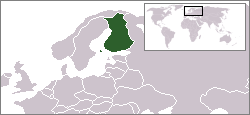Finland
| Republic of Finland | |
|---|---|

| |
 
| |
| National anthem | Maamme |
| Capital | Helsinki |
| Official language | Finnish, Swedish |
| Government type | Republic |
| President | Tarja Halonen |
| Prime Minister | Matti Vanhanen |
| Area | 338,145 km² 130,558 mi² |
| Population | 5,238,460 (113th) (2007 estimate) |
| Population density | 17/km² (192nd) |
| HDI | 0.947 (high) (11th) (2004) |
| Currency | Euro (EUR) |
| Time zone | EET (UTC+2) Summer:EEST (UTC+3) |
| Country codes | Internet TLD : fi Calling code : +358 |
The Republic of Finland (Suomen Tasavalta in Finnish and Republiken Finland in Swedish) is a country in North-East Europe. It is neighbored by Russia in the east, Sweden in the west and Norway in the north. In the south, the coast extends to the Baltic Sea. Finland has been an independent state since 1917, and a member of the European Union since 1995.
Politics
Finland is a republic, and has a unicameral parliament. The president is elected for a six-year post, with one possible re-election. While the role of the president is mostly symbolic, the acting president has duties such as representing the country abroad and accepting all new legislation. The parliament, or Eduskunta, has 200 seats for members that are chosen in a general election every four years. The parliament usually consists of 2-3 coalition parties and a few opposition parties. At the moment, the coalition is formed by the center, moderate, Swedish and green parties.
Local Government
Finland is divided into six provinces (lääni), which all have their own local government. These governments work as the local subdivisions of the parliament in matters such as education, rescue and police operations, traffic, social services, and health care. Åland, a demilitarized archipelago in the Baltic Sea, is an exception among the provinces with a high level of autonomy.
Each municipality also has its own council, elected every 4 years.
Education
All children must enroll in a primary school in the year they turn seven. What usually follows is six years of primary school, and then three years of lower secondary school. This completes the obligatory schooling. After these nine years, there are two main routes to higher education: the vocational and the academic system. Vocational schools prepare the student for a specific profession and include work experience as part of the curriculum. The academic route prepares the student for studies at a university or polytechnic college. It is also possible to combine a vocational degree with the national matriculation diploma.
The vast majority of schools in Finland are state-owned and free for the students. There is a national curriculum to be followed, and nation-wide testing of students.
Economy
Finland is a developed country whose main products are manufactured wood and metals as well as telecommunications and engineering products. The trade sector is extensive due to Finland's limited agricultural possibilities and dependence on foreign energy.[1] The prevalence of forests has enabled the timber industry to quickly develop, and wood products are among the more important exports.
Finland has been using the Eurozone currency, Euro, since 2002. Income-wise the country ranks high among the countries of the world, with a GDP of $33,000 per capita, ranked 21st.[2] The beginning of the 21st century has been marked with modest growth in the economy[3] and inflation has also been moderate.[4] However, the unemployment rate has remained relatively high, presently at 10.5%.[5]
Military
The top military organization in Finland is called Puolustusvoimat, or the Finnish Defence Forces. It is divided into the army, the navy and the air forces. Finlad has striven to maintain a policy of neutrality, and since World War II has participated in many peace-keeping operations. Although membership in the military organization NATO has been considered, so far the public opinion has been against joining.
Military service is obligatory in Finland, and all men are called into service at the age of 18. They can choose whether to serve in the military (the minimum service is 6 months), or do a year of civil service. Human rights groups have criticized Finland for the length of the civil service and for imprisoning men who refuse to complete their service in either way.[6]
Demographics
The clearly predominant group of people in Finland are Finns (some 93% of the population.[7] Another noteworthy group are Finnish-Swedes, some 6%. There are also some small Russian communities throughout Finland, especially in the Eastern parts.
Languages
Finnish has been an official language of the country since the declaration of independence. Due to its long history under the Swedish rule, Finland has also maintained Swedish as a second official language. All citizens are taught both official languages in primary and/or lower secondary school. All government officials should be able to speak both languages.
Religion
The main religion is the Finnish Lutheran Church (84%[8] ). Others include the Orthodox church and Pentecostalism.
External links
References
- ↑ CIA World Factbook 2006 (Economy)
- ↑ CIA World Factbook (GDP Rank)
- ↑ Statistics Finland: National Output
- ↑ Statistics Finland: Inflation
- ↑ Statistics Finland: Employment (May 2010)
- ↑ Amnesty International Report 2007, available at http://thereport.amnesty.org/eng/Regions/Europe-and-Central-Asia/Finland
- ↑ The CIA Factbook 2006, available at https://www.cia.gov/library/publications/the-world-factbook/geos/fi.html#People
- ↑ The CIA Factbook 2006, available at: https://www.cia.gov/library/publications/the-world-factbook/geos/fi.html#People